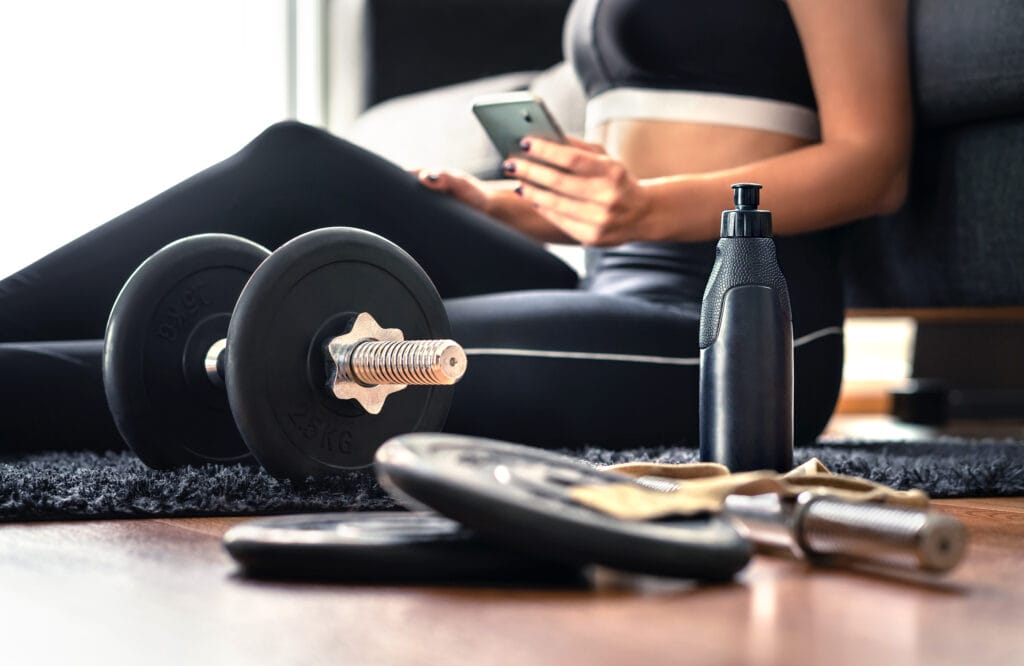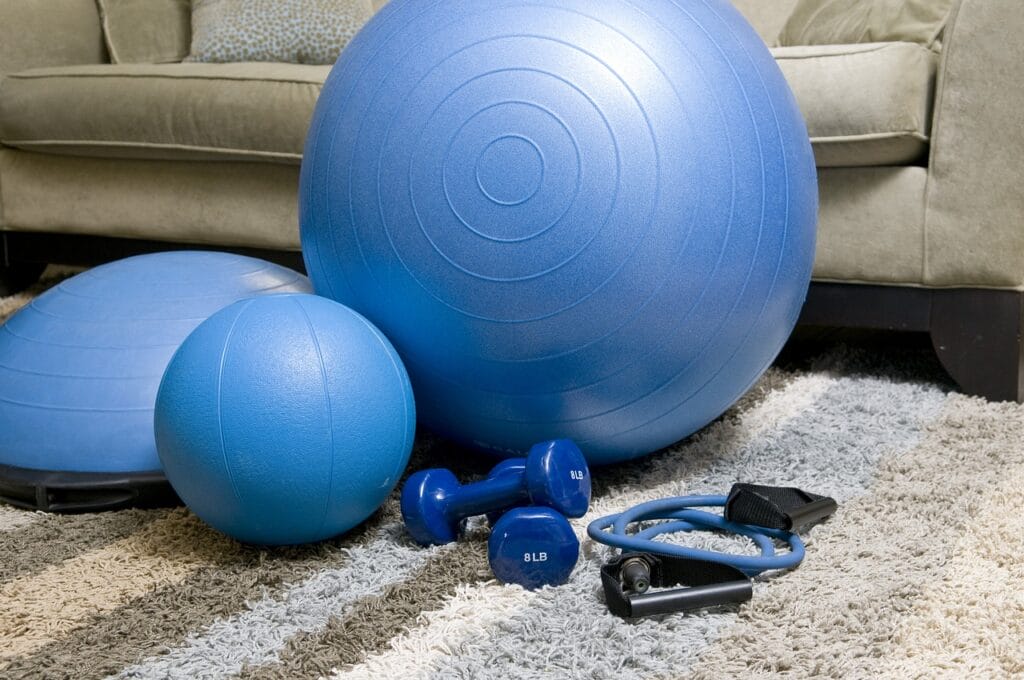
Creating a home gym is an exciting endeavor that offers convenience, flexibility, and personalized fitness experiences tailored specifically to you.
And whether you’re transforming a spare room, basement, garage, or any other dedicated space into a fitness sanctuary, thoughtful design considerations can help you make the most of your space.
In this comprehensive guide, we’ll explore essential home gym design tips to help you create an inspiring and effective workout environment that’ll help you make the most of your home gym.
1. Define Your Fitness Goals and Space Requirements
Before diving into the aesthetics and layout of your home gym, it’s crucial to have a clear understanding of your fitness goals, aspirations, and priorities.
Are you focusing on weight loss, muscle building, endurance training, flexibility enhancement, or overall wellness?
By identifying specific objectives, you can tailor your home gym design and layout to align with your unique needs and preferences.
Assessing Available Space
Once you’ve defined your fitness goals, you’ll want to assess the available space in your home to determine the feasibility and constraints of your home gym project.
Measure the dimensions, layout, and features of the designated area, and don’t forget to consider factors like ceiling height, floor space, wall dimensions, doorways, windows, electrical outlets, and ventilation to accommodate equipment.
And if your workout space is limited, don’t fret – there are tons of compact fitness machines to choose from these days.
From small walking treadmills to stair climbers that can fit in the corner, you can rest assured you’ll be able to find equipment that’ll fit your space.
Prioritizing Equipment and Amenities
Based on your fitness goals and space requirements, prioritize essential equipment, machines, and amenities that align with your goals and available space.
Consider versatile, multi-functional options, that can serve multiple purposes, like:
- adjustable dumbbells
- resistance bands
- kettlebells
- stability balls
- TRX trainers
You could also think about going with modular equipment systems that maximize functionality, flexibility, and efficiency within limited or constrained spaces.
Creating a Layout Blueprint
Develop a comprehensive layout blueprint or floor plan that integrates your fitness goals and space requirements.
This’ll come in handy when trying to figure out what kind of equipment to prioritize.
It’s a good idea to take measurements of your actual floorspace and keep these in mind when searching for fitness equipment – and don’t forget to check the assembled dimensions for any prospective purchases.
Experiment with different configurations, arrangements, and spatial arrangements for optimal flow and usability.
This becomes more of an issue with larger home gyms, but it’s important for smaller and shared workout spaces as well.
Incorporating Design Principles
Consider factors such as color schemes, lighting, textures, materials, finishes, and decor elements that resonate with your personality.
Having a fun and welcoming environment can enhance ambiance and make your home gym more enjoyable to use.
Which means you’ll be more likely to keep using it for the long run.
Seeking Professional Guidance
If you’re uncertain about defining your fitness goals, assessing space requirements, or creating a cohesive home gym design, consider seeking professional guidance.
This could mean getting a consultation with an interior designer or asking for assistance from a local fitness expert.
But it could also be as simple as finding a home improvement professional who has experience in creating personalized home gym environments.
2. Prioritize Functionality and Safety
Equipment Placement
Strategically position exercise equipment, machines, and accessories to optimize flow, accessibility, and usability during workouts.
Ensure adequate spacing between equipment and make sure you have clear pathways to access everything safely.
Keep in mind how much room you’ll need to comfortably use your equipment as well.
When it comes to a treadmill or exercise bike, you don’t need a ton of wiggle room around it, but most home gyms require a few extra square feet for efficient use.
Oh, and don’t forget to consider electrical outlet placements – if you plan on using equipment that needs to be plugged in, make sure you can place it near an outlet.
The last thing you want is annoying extension cords cutting through your workout space.
Safety Measures
Incorporate safety considerations, such as proper ventilation, flooring, and lighting to ensure a hazard-free workout environment.
You can consider install appropriate flooring materials, padding, mirrors, and storage solutions to enhance safety and make for a more organized gym.
And depending on the kind of equipment you’ll be using, it’s not a bad idea to have a fire extinguisher within easy access.
You know, just in case.

3. Embrace Aesthetics and Inspiration
Personalized Design
Infuse your home gym with inspiring, motivating, or otherwise energizing design elements that you like.
Using fun colors, textures, and decor that resonate with your personality will add to the whole experience of working out from home.
Don’t be afraid to incorporate vibrant colors, motivational quotes, artwork, plants, mirrors, and lighting fixtures to create a stimulating environment.
Working out from home is uplifting and empowering so own it.
It’s also fun to celebrate progress and milestones with visual reminders.
You could have a dry erase board with PR’s listed or a shelf with displays or medals earned from participating in races.
At the end of the day, it’s all about creating an atmosphere that encourages consistency in your workouts.
4. Optimize Organization and Storage Solutions
Efficient Layout
Design an efficient and organized layout that maximizes space.
It’s important that you’re able to comfortably access all of your equipment, but you’ll also want to be able to access and store any accessories and other supplies you may need.
Incorporating versatile storage solutions can go a long way.
Consider using things like:
- shelves
- racks
- bins
- drawers
- cabinets
- wall hooks
Simply adding a small storage bin or wall hook can make a world of difference when it comes to organizing resistance bands, gloves, or other small items.
The goal is to maintain order and minimize clutter.
Accessibility and Convenience
Prioritize accessibility and ease of use by arranging equipment and supplies based on frequency of use.
Prioritize the equipment you see yourself using the most and put these items in the most accessible areas of your gym.
For example, my home gym is centered around our Force USA X15 Pro.
This is our largest, most-used piece of equipment, so we placed it against a wall in the middle of our home gym space and everything else was placed accordingly around it.
You can also create designated zones or areas for specific exercises to streamline workouts and optimize productivity during each session.
5. Consider Flexibility and Adaptability
Modular Design
Consider designing your home gym with a modular layout that’ll give you flexibility to accommodate future growth.
This depends largely on your home setup, but if possible, it’s nice to have an adaptable space that can be modified based on your fitness growth and preferences.
Down the road you might want additional equipment and it would be nice to have a working layout that can handle additional equipment in the future.
Incorporate versatile design elements, furniture, fixtures, or configurations that allow for easy adjustments.
You can also think about creating multi-functional spaces within your home gym that serve dual purposes.
Examples include:
- a yoga/stretching area
- a meditation zone
- cardio corners
- or strength training stations that accommodate several exercises
Final Thoughts
Working out in your own home gym comes with a ton of benefits, especially if you can create a fully-functioning gym that allows you to cancel a commercial gym membership.
It’s awesome not having to pay that monthly fee, but it’s also great not having to make that commute.
Nothing beats being able to walk downstairs to workout and I can’t remember the last time I had to wait in line for a machine.
I know designing your home gym can be daunting, but try not to get too stressed out – have fun with it.
Designing a home gym is more than creating a space; it’s about cultivating a personalized and empowering environment that reflects your commitment to fitness.
It’s necessary to consider your floorspace because you need to make sure you have the necessary room to fit any equipment you’re considering, but it’s important to put your personal touch on it too.
By embracing personalization and prioritizing sustainability within your home gym, you can create a fulfilling experience that resonates with your wants and needs.
And if you prioritize functionality and organization, you can create an effective workout environment that motivates and empowers you along your fitness journey.
So, I encourage you to embrace the possibilities and have fun customizing your home gym!


